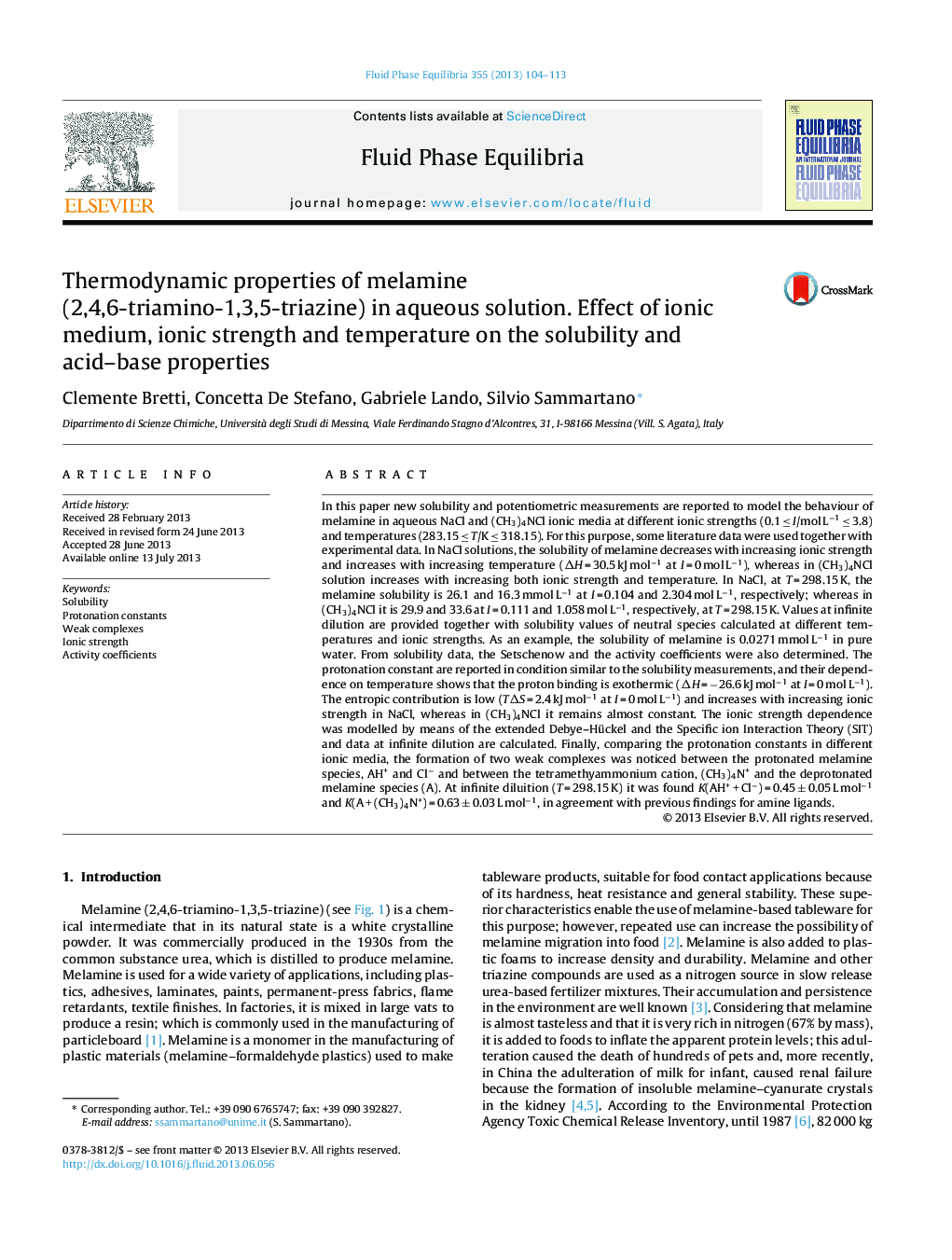| Article ID | Journal | Published Year | Pages | File Type |
|---|---|---|---|---|
| 201908 | Fluid Phase Equilibria | 2013 | 10 Pages |
•Melamine solubility is 0.027 mol L−1 in pure water at T = 298.15 K.•Opposite salt effect are observed for solubility in NaCl and (CH3)4NCl solutions.•Melamine protonation constant in NaCl is higher than in (CH3)4NCl.•Melamine protonation enthalpy is negative and the entropic contribution is low.•Two weak species were determined, AHCl and (CH3)4NA+ (A = melamine neutral species).
In this paper new solubility and potentiometric measurements are reported to model the behaviour of melamine in aqueous NaCl and (CH3)4NCl ionic media at different ionic strengths (0.1 ≤ I/mol L−1 ≤ 3.8) and temperatures (283.15 ≤ T/K ≤ 318.15). For this purpose, some literature data were used together with experimental data. In NaCl solutions, the solubility of melamine decreases with increasing ionic strength and increases with increasing temperature (ΔH = 30.5 kJ mol−1 at I = 0 mol L−1), whereas in (CH3)4NCl solution increases with increasing both ionic strength and temperature. In NaCl, at T = 298.15 K, the melamine solubility is 26.1 and 16.3 mmol L−1 at I = 0.104 and 2.304 mol L−1, respectively; whereas in (CH3)4NCl it is 29.9 and 33.6 at I = 0.111 and 1.058 mol L−1, respectively, at T = 298.15 K. Values at infinite dilution are provided together with solubility values of neutral species calculated at different temperatures and ionic strengths. As an example, the solubility of melamine is 0.0271 mmol L−1 in pure water. From solubility data, the Setschenow and the activity coefficients were also determined. The protonation constant are reported in condition similar to the solubility measurements, and their dependence on temperature shows that the proton binding is exothermic (ΔH = −26.6 kJ mol−1 at I = 0 mol L−1). The entropic contribution is low (TΔS = 2.4 kJ mol−1 at I = 0 mol L−1) and increases with increasing ionic strength in NaCl, whereas in (CH3)4NCl it remains almost constant. The ionic strength dependence was modelled by means of the extended Debye–Hückel and the Specific ion Interaction Theory (SIT) and data at infinite dilution are calculated. Finally, comparing the protonation constants in different ionic media, the formation of two weak complexes was noticed between the protonated melamine species, AH+ and Cl− and between the tetramethyammonium cation, (CH3)4N+ and the deprotonated melamine species (A). At infinite diluition (T = 298.15 K) it was found K(AH+ + Cl−) = 0.45 ± 0.05 L mol−1 and K(A + (CH3)4N+) = 0.63 ± 0.03 L mol−1, in agreement with previous findings for amine ligands.
Graphical abstractActivity coefficients (log γ) of melamine in NaCl at 310.15 (Δ) and 298.15 K (□) and in (CH3)4NCl at 310.15 (○) and 298.15 K (▿).Figure optionsDownload full-size imageDownload as PowerPoint slide
